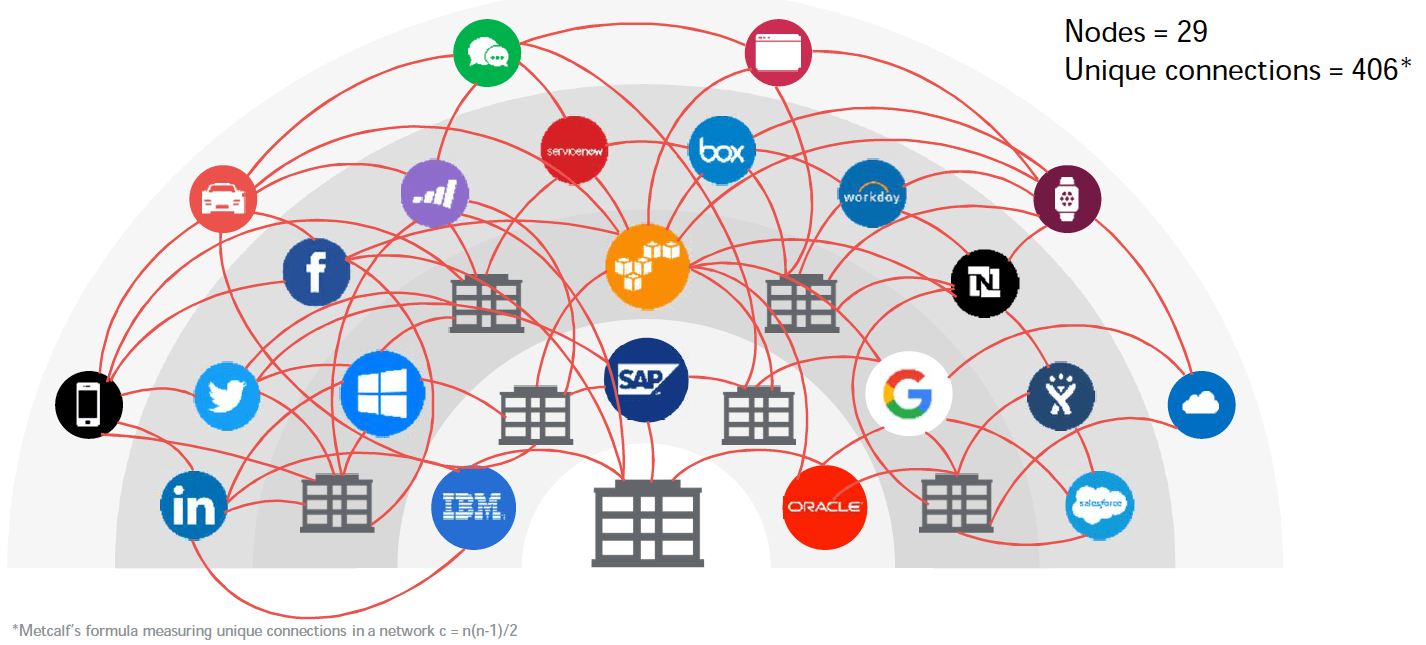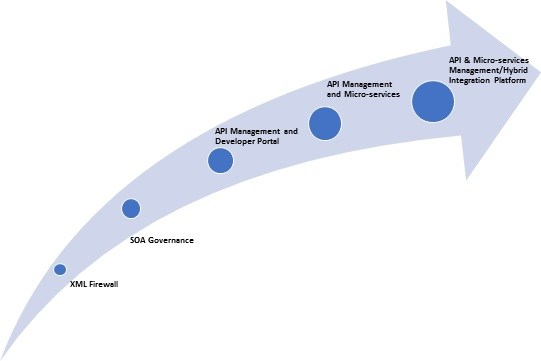The Challenge: Increasing Enterprise Sprawl
It is widely known how enterprises have changed over the years from having IT function as a centralized service provider for everything related to technology to having to manage systems spread across a mix of SaaS, PaaS, and on-premise data centers. In addition, traditional boundaries of an enterprise have been blurred with customer experience networks (how enterprises do business with customers in the Digital world – B2B, B2C, B2D2C) now spreading outside into service providers and/or business partners. Below is an illustration of current day Enterprise sprawl which presents the challenge of enterprises having to manage, scale and have visibility over business processes across multiple information systems while ensuring seamless customer experience in Hybrid Integration Architecture.

Today’s reality – Enterprise sprawl revisited
How did we end up with this mess?
If we look back, it will be clear that this challenge of Enterprise sprawl has not surfaced suddenly rather there have been cycles of increased sprawl. One of the cycles where it was first noticed was when enterprises merged or got acquired and the new business entity (specifically IT Dept) ended up with managing multiple core IT systems. Another example is a more recent cycle of the sprawl, critical information systems like CRM, ITSM, and ERPs have been acquired as SaaS on a public cloud which made the sprawl bigger and complex. And today we see in order to thrive as a digital business, it is imperative to work within the whole ecosystem where information systems are shared with business partners and the consumers. So, the enterprise sprawl indeed is a messy thing to deal with in the Hybrid Integration Architectures.
The emergence of Hybrid Integration Architectures
As enterprises raced to adapt to a new cloud-driven world, many turned to outsourced services to fulfill their needs. To avoid giving up too much control, most deployed a combination of public and private clouds. This gave rise to the Hybrid Cloud.
But not every application/system belongs to the cloud. Organizations found you can achieve greater efficiencies and tighter security by integrating cloud services with existing, on-premise IT infrastructure. So, somewhere in the mid-cycle of Enterprise sprawl Hybrid IT emerged requiring Hybrid Integration architectures. Hybrid Cloud has taken off since and according to some it is the norm!
APIs are critical for Hybrid Integration
From the beginning when the IT systems started to be spread out, there have been many ways information has been exchanged – XML based SOAP/Web Services to current day RESTful services or IoT protocols. However, the foundation for this has been Application Programming Interfaces (API).
Below shows the evolution of the API Management space over the past 15 years where solutions like Axway Amplify API Management have catered to early use cases of XML security offering Edge/DMZ devices or appliances, SOA Governance to more recently Lifecycle Management of APIs (predominantly RESTful in nature) or Hybrid/Cloud-to-ground use cases.

Evolution of API Management solution space over the last 15 years
With Cloud now becoming mainstream and agility, time to market a key requirement for enterprises to not only retain market share but gain competitive advantage, applications are being rebuilt using modern architecture around microservices in order to scale.
How to battle the challenge of the sprawl?
With more and more developers now jumping on the micro-services bandwagon, it is not a surprise that the next area of focus in the API Gateway/Management seems to be Micro-services Management within a Service Mesh. With modular micro-services Hybrid Integration Architecture, it will be much easier for enterprises to manage the current enterprise sprawl. The question is what are all the ingredients required in order to succeed as a Digital Business. Would what Gartner calls as a hybrid integration platform (HIP) provide the answer?
Read also Axway API Management business cases:
- Danish Defense – Automating processes and cutting costs delivers quick ROI for the Danish Defense.
- Essent – Axway API Gateway is the starting point for unlocking information for customers at Essent.
- Star Entertainment Group – Generating revenue from new customer-facing digital channels with Axway API Management.
Read more about Hybrid Integration Architecture here.

Follow us on social